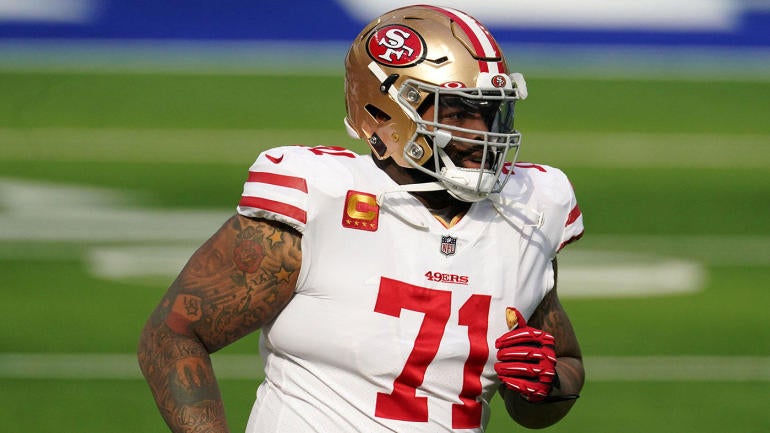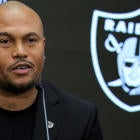
An agent can't get something for a client if they don't ask for it. The risk of pricing a client out of the market is much greater this year because of the salary cap dropping from $198.2 million to $182.5 million.
Nonetheless, Pro Bowl-caliber players and the top talent at each respective position are still likely to get major paydays if high-end contract extensions signed after the initial $175 million 2021 salary floor was set by the NFL and NFLPA are any indication. For example, the Chargers didn't hesitate in making Joey Bosa the highest-paid defensive player in NFL history at $27 million per year days after the agreement on the 2021 salary cap was reached in late July. The 49ers dramatically reset the tight end market when they signed George Kittle to a $15 million-per-year extension during the preseason. Rams cornerback Jalen Ramsey became the league's first $20 million-per-year defensive back right before the 2020 regular season started.
While working on the agent side of things, it was my responsibility to create target or asking prices for the firm's clients headed toward free agency regardless of whether I was the lead agent. In that spirit, I have set target prices with total contract value, overall guarantees, amount fully guaranteed at signing and first-three-years compensation (when applicable) for 10 intriguing offensive players who will be unrestricted free agents or were designated as franchise players.
Players don't necessarily sign for their target prices because free agency is a fluid process where adaptations must be made to changing market conditions. Some players are disappointed with the outcome of free agency because their market never develops for a variety of reasons (age, unrealistic contract demands, supply at playing position, etc.).
Remember that the target or asking prices for these players may be on the high side and aren't necessarily what their actual deals will be.
Contract package: $117.5 million, five years ($23.5 million per year)
Overall guarantees: $72 million
Fully guaranteed at signing: $55 million
First three years: $72 million
The 49ers couldn't designate Williams as a franchise or transition player because of a clause included in his contract after he was traded from the Washington Football Team during the middle of the 2020 NFL Draft when left tackle Joe Staley retired. Williams remained one of the league's top left tackles following a 2019 season that was primarily lost because of contract unhappiness and a dispute over Washington's handling of a medical issue. He earned his eighth Pro Bowl berth in 2020.
Left tackles of Williams' caliber rarely hit the open market. Fortunately for Williams, the left tackle market exploded in 2020 -- although he turns 33 in July.
Laremy Tunsil became the NFL's first $20 million-per-year offensive lineman when he signed a three-year, $66 million extension containing $50 million of guarantees ($40 million fully guaranteed) with the Texans last offseason. Ronnie Stanley received a five-year, $98.75 million extension worth up to $100 million through incentives from the Ravens at the end of October. The deal contains record-setting guarantees for an offensive lineman contract. There are a little more than $65.5 million in overall guarantees with slightly more than $58.8 million fully guaranteed at signing. David Bakhtiari replaced Tunsil as the highest-paid offensive lineman in NFL history when the Packers gave him a four-year, $92 million extension (worth up to $94 million through incentives and salary escalators), averaging $23 million per year last November.
(Franchise player)
Contract package: $90 million, four years ($22.5 million per year)
Overall guarantees: $60 million
Fully guaranteed at signing: $48 million
Robinson would have been in high demand on the open market if the Bears hadn't designated him as a franchise player. It's going to cost the Bears $17.98 million because he is entitled to a 20% increase over his $15 million 2020 salary cap number under the NFL's collective bargaining agreement rules after subtracting out his $100,000 workout bonus then adding it back after the raise. There has been speculation that the Bears will trade Robinson, much like the Dolphins did with Jarvis Landry in 2018 after giving him a franchise tag. Talks between Robinson and the Bears failing to produce a new contract last year led to rumors of him requesting a trade.
Robinson surely took note of the four-year extension wide receiver Keenan Allen got from the Chargers early last September -- averaging $20.25 million per year with $50 million of guarantees -- while he was still negotiating with the Bears. Shortly thereafter, DeAndre Hopkins replaced Julio Jones -- whose three-year extension from the Falcons averaged $22 million per year -- as the league's highest-paid wide receiver on his two-year, $54.5 million extension ($27.25 million per year) with the Cardinals.
Robinson has thrived in Chicago despite shaky quarterback play. He has the NFL's fourth-most receptions (200) and receiving yards (2,397) over the last two seasons.
(Franchise player)
Contract package: $68 million, four years ($17 million per year)
Overall guarantees: $40 million
Fully guaranteed at signing: $35 million
The Washington Football Team designated Scherff as a franchise player for a second straight year. Scherff's franchise tag is $18.036 million, which is 120% of his $15.03 million designation in 2020. He is coming off a 2020 Pro Bowl season, his fourth selection over a five-year span. Scherff also received his first All-Pro nod last season.
The second tag complicates matters because his representation could view the $18.036 million number as a good barometer of what Washington should pay Scherff on a long-term deal, but there has never been a $15 million-per-year offensive guard in the NFL. Since Scherff is scheduled to make $33.066 million in 2020 and 2021 by going year-to-year on the franchise tag, Washington shouldn't expect to keep Scherff in the fold for less than his $16.533 million average per year. A third franchise tag in 2022 is out of the question because it would be either $25,971,840 at the CBA-mandated 44% raise over his $18.036 million designation or the 2022 non-exclusive quarterback number, whichever is greater.
Contract package: $65 million, five years ($13 million per year)
Overall guarantees: $35 million
Fully guaranteed at signing: $27.5 million
First three years: $40.5 million
Free agency hasn't been kind to running backs in recent years. Le'Veon Bell is the only one to get a lucrative contract. The Jets were essentially bidding against themselves during 2019 free agency when they signed Bell to a four-year, $52.5 million deal (worth up to $60.15 million through incentives and salary escalators) with $27 million fully guaranteed at signing -- a then veteran running back contract record for guarantees. The other high-priced running backs (Ezekiel Elliott, Derrick Henry, Alvin Kamara, Christian McCaffrey, etc.) re-upped with their own teams. Bell is also a cautionary tale against spending big on a running back in free agency. The Jets released a disgruntled Bell five games into last season.
There are conflicting reports over what the Packers have offered Jones. According to ESPN's Rob Demovsky, Jones was offered top-five running back money. This would mean at least $12.5 million per year. The problem was the offer lacked substantial guaranteed money, which is customary in Green Bay veteran contracts. NFL Media's Ian Rapoport characterized Green Bay's offers as more than $9 million per year.
Jones had been one of the NFL's most productive running backs over the last two seasons. He is one of five running backs to reach 1,000 rushing yards consecutively. Jones has 3,017 yards from scrimmage (combined rushing and receiving yards) since 2019, which is the NFL's fifth-most during that span. His 25 rushing touchdowns rank third in the NFL.
Contract package: $50 million, four years ($12.5 million per year)
Overall guarantees: $27.5 million
Fully guaranteed at signing: $23 million
The Chargers are letting Henry hit the open market this time around after he played the 2020 season on a $10.607 million franchise tag. Presumably, the Chargers would have signed Henry to a long-term deal if he had been willing to take something comparable to Austin Hooper's deal. Hooper became the NFL's first tight end to sign for more than $10 million per year in free agency last year when he received a four-year, $42 million contract from the Browns with $23 million in guarantees where $18.5 million was fully guaranteed at signing. Since the Hooper deal, George Kittle dramatically reset the tight end market with the $15 million-per-year deal he got from the 49ers on a five-year extension containing $40 million in overall guarantees and $30 million fully guaranteed at signing. Chiefs tight end Travis Kelce quickly followed suit by signing a four-year extension averaging $14,312,500 per year with a team-friendly structure.
(Franchise player)
Contract package: $47.25 million, three years ($15.75 million per year)
Overall guarantees: $33 million
Fully guaranteed at signing: $30 million
Moton had a good case along with Jack Conklin for being the NFL's best right tackle in 2020. Conklin is the most recent relevant data point for right tackles. He signed a three-year, $42 million contract containing $30 million fully guaranteed with the Browns in free agency last year. Lane Johnson (Eagles) is the league's highest-paid right tackle at $18 million per year. The Panthers made sure Moton isn't going anywhere this year thanks to a franchise tag. Moton's number is $13.754 million.
Contract package: $51 million, four years ($12.75 million per year)
Overall guarantees: $30 million
Fully guaranteed at signing: $27.5 million
There were five centers with contracts averaging $11 million per year or more during the 2020 season: Rodney Hudson, Ryan Kelly, Nick Martin, Mitch Morse and Maurkice Pouncey. Kelly leads the way with the four-year extension averaging $12,412,500 per year he received from the Colts last September. The deal contains $34 million in guarantees, of which $25.35 million was fully guaranteed at signing. Linsley earned first-team All-Pro honors in 2020.
Contract package: $10 million, one year (worth up to $15 million with incentives)
Overall guarantees: $10 million ($9 million as signing bonus with up to four voiding/dummy years for salary cap purposes)
A tepid free agent market led to Winston signing a one-year, $1.1 million deal worth up to $4.7 million through incentives last offseason. With Drew Brees expected to retire, re-signing Winston is reportedly a priority for the Saints. When Brees missed four games last season because of broken ribs and a collapsed lung, Taysom Hill got the nod at quarterback over Winston. Wanting to be in the same territory financially as Hill in an open competition to replace Brees would be a reasonable position for Winston to take. Hill signed a two-year, $21 million contract with an additional $1 million in incentives as a restricted free agent last year. Since Hill's restricted free agent tender was $4.641 million, he gave up one unrestricted free agent year for $16.359 million.
Contract package: $48 million, three years ($16 million per year)
Overall guarantees: $34 million
Fully guaranteed at signing: $34 million
The Titans declined a $15.68 million fifth-year option on Davis for 2021 when the decision needed to be made last May because he hadn't had a true breakout season and 2019 second-round pick A.J. Brown quickly became quarterback Ryan Tannehill's favorite target. Davis responded with a career year in 2020. He had 65 receptions for 984 yards with five touchdowns in 14 games.
Davis hasn't demonstrated he can be the primary receiving threat in an offense but is more productive than a number two wide receiver. Last September, the Rams signed wide receivers Robert Woods and Cooper Kupp to extensions averaging $16.25 million and $15.75 million per year, respectively. A team believing Davis can live up to the potential that made him 2017's fifth overall pick could be the key to getting in this financial neighborhood. Since Davis is 26 years old, he might be inclined to only sign for three years thinking he could get a bigger payday on his next contract while he is still in what should be his prime once the salary cap starts increasing dramatically because of new media rights deals.
Contract package: $23 million, four years ($5.75 million per year)
Overall guarantees: $12 million
Fully guaranteed at signing: $10 million
The 49ers raised eyebrows in 2017 by signing Juszczyk to a four-year, $21 million deal that averaged over twice as much as the NFL's second-most lucrative fullback contract. Four years later, the fullback market hasn't come close to catching up with Juszczyk's deal. Ravens two-way player Patrick Ricard, who provides depth at defensive tackle, is the second-highest paid with the two-year extension averaging $3.65 million per year he signed late in the 2019 season. To justify being so above the rest of the market, Juszczyk's versatility will need to continue being exploited where he is on the field -- similarly to what he has been doing during his 49ers tenure, where he saw nearly 45% of the offensive snaps. Juszczyk's deal was signed when the salary cap was $167 million. It is approximately $5.75 million per year under 2021's $182.5 million salary cap.








































